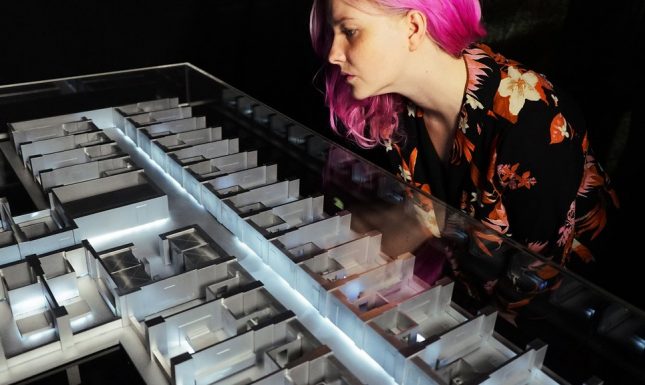Absence as Visualization of the Invisible: The Affective Force of Art During a Global Pandemic
How can contemporary artworks complement and enhance education in the life sciences? A short review of the affective force of art in the exhibition Contagious! at the Rijksmuseum Boerhaave in Leiden, on show until 9 January 2021.
According to Professor Robert Zwijnenberg, the domains of art and science are continuously defined in oppositional terms, delineating a hierarchical relationship between the two disciplines. The integration of the arts and sciences, however, may provoke novel insights in both fields, enabling the grounds for a more holistic approach towards the production of knowledge. The temporary exhibition Contagious!, on show at the Rijksmuseum Boerhaave in Leiden, exemplifies the potential that such an integrated approach can have in educating audiences about scientific discourses. Within the context of the current COVID-19 pandemic, Contagious! addresses the historical and contemporary representation, treatment and cures of contagious diseases, allowing audiences to witness scientific development in real time. The exhibition further complements scientific facts with anatomical drawings, realistically rendered wax models, and contemporary artworks.

The artwork A Cluster of 17 Cases (2018, fig. 1-4) by the artist collective Blast Theory is particularly noteworthy, as it provides an alternative approach to the seemingly rational-oriented medical sciences by evoking an affective, emotional response in its viewers. The installation consists of a three-dimensional model of the Metropole Hotel in Hong Kong, where the SARS virus infected 17 hotel guests on February 21st in 2003, who subsequently transmitted the virus to 546 people across the globe. The artwork is accompanied by an audio recording, recalling the night’s events from the perspective of a 22 year old woman who contracted the virus in the Metropole Hotel. As the woman narrates her experience, the individual hotel rooms gradually light up red, illuminating the virus’ quick spread during that fateful night.

Despite lacking a concrete representation of human figures, this artwork aids in the visualization of the disease it alludes to through its affective qualities. It is precisely the lack of embodiment or personification that creates a space of absence into which viewers can insert their own subjectivity. A Cluster of 17 Cases therefore invites viewers to engage in personal introspection, allowing them to address and process the pain and uncertainty the pandemic poses. In this sense, the artwork complements the more scientific displays at the exhibition. The wax replicas of diseased bodies exhibited in Contagious!, for instance, have distinct human features that clearly separate the portrayed disease from the viewer, instead manifesting in the body of another. Contrastingly, the absence of clear personification in the empty hotel rooms in A Cluster of 17 Cases encourages viewers to become present in the work. Moreover, the artwork transports audiences into the portrayed space, imagining themselves walking its hallways as the audio recounts the woman’s steps before being infected.

Considering the current COVID-19 pandemic, this prompts a confrontation with our own mortality, therefore resonating with the observer on an emotional level. It is simultaneously unsettling and humbling, as the audience is faced with their own privileged position in the relatively safe museum space in juxtaposition to the lived experience of those affected and killed by the virus. The visualization of the virus' deadly toll through absence of human embodiment further channels philosopher Roland Barthes’ concept of what-has-been; an eerie reflection of a person’s imminent death. The audience is thus reminded that the casualties caused by contagious diseases are more than a statistic; more than the number of cases and deaths portrayed on a screen by the entrance of the exhibition. Such statistics are often so abstract and removed from human experience that they may make the human suffering encapsulated within them incomprehensible to the museum visitor. The juxtaposition of scientific information with artworks such as A Cluster of 17 Cases can therefore enable viewers to visualize the lives that are at stake, prompting a more tangible, holistic understanding of contagious diseases.

In this sense, the combination of scientific and artistic displays in the exhibition Contagious! exercises an affective force over the audience, compelling viewers to empathize with people who have been directly affected by the pandemic, and thus demonstrating the potential of cultivating a new sense of awareness in the natural sciences through art.
Biography: Anna Loh is a first year research Master’s student in Arts and Culture at Leiden University. Her research interests lie in the intersections of contemporary visual art and digital culture, as well as gender studies.
Recommended Literature:
Barthes, Roland. Camera Lucida: Reflections on Photography, trans. R. Howard. New York: Hill and Wang, 1981.
Zwijnenberg, Robert. “Art, the Life Sciences, and the Humanities: In Search of a Relationship,” in Art in the Age of Technoscience : Genetic Engineering, Robotics, and Artificial Life in Contemporary Art, ed. Reichle and Custance, xiii-xxix. Wien: Springer, 2009.
Image Reference:
Blast Theory. A Cluster of 17 Cases. 2018. Images. Blast Theory. Accessed October 3, 2020. https://www.blasttheory.co.uk/blast-theory-17-cases/.


0 Comments